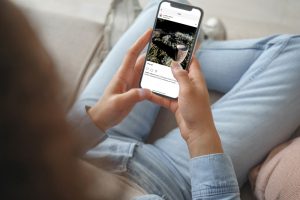
In the vibrant world of digital marketing, the end of a seasonal campaign often brings a sigh of relief for marketers. They have poured countless hours and resources into crafting the perfect campaign, only to watch it culminate in a flurry of activity during peak periods. However, as the confetti settles and the holiday lights dim, many businesses find themselves grappling with a disheartening reality: a significant drop in engagement rates. Understanding why this phenomenon occurs and how to combat it is crucial for sustaining customer relationships and maintaining brand visibility.
The Post-Season Engagement Decline
According to a report by WebEngage, a staggering 70% of marketers struggle to retain customers once the festive season concludes. This decline in engagement can be attributed to several factors, including shifts in consumer behavior, increased competition, and the inherent difficulty of maintaining promotional momentum beyond peak periods.

Changes in Consumer Behavior
During seasonal campaigns, consumers are often driven by urgency and excitement. The festive spirit, coupled with limited-time offers, creates a sense of urgency that prompts immediate action. However, once the season ends, this urgency dissipates, leaving consumers to revert to their regular purchasing habits. The excitement that once fueled engagement is replaced by a sense of normalcy, making it challenging for brands to capture attention.
Increased Competition
The digital landscape is saturated with brands vying for consumer attention. During peak seasons, businesses often ramp up their marketing efforts, leading to an overwhelming number of promotional messages. Once the season ends, this competition does not vanish; instead, it transforms into a quieter, yet equally fierce, battle for engagement. Brands that fail to adapt their strategies post-season may find themselves lost in the noise, struggling to maintain visibility in a crowded marketplace.
Sustaining Promotional Momentum
Creating a successful seasonal campaign requires meticulous planning and execution. However, sustaining that momentum once the campaign concludes is a different challenge altogether. Many businesses lack a clear strategy for transitioning from a high-activity period to a more subdued phase, leading to a drop in engagement rates. Without a robust post-campaign plan, brands risk losing the connection they forged with consumers during the festive season.
Strategies for Post-Festive Customer Retention
To combat the decline in engagement rates after seasonal campaigns, businesses can implement several effective strategies:
1. Personalized Follow-ups
Utilizing customer data to send personalized thank-you emails or messages can significantly enhance post-season engagement. Acknowledging holiday purchases and offering tailored recommendations demonstrates appreciation and keeps the brand relevant in customers’ minds. For instance, a clothing retailer might send a follow-up email featuring outfit suggestions based on a customer’s recent purchases, encouraging further interaction.

2. Loyalty Programs
Introducing or enhancing loyalty programs can incentivize customers to continue engaging with the brand beyond the holiday season. Offering exclusive benefits, points, or rewards for repeat purchases fosters a sense of belonging and encourages customers to return. For example, a coffee shop could implement a loyalty program that rewards customers with a free drink after a certain number of purchases, enticing them to come back for more.
3. Post-Holiday Exclusive Deals
Launching targeted campaigns in January with special offers or discounts for holiday shoppers can help convert one-time buyers into repeat customers. By providing additional value, brands can entice customers to return and make further purchases. An electronics store, for instance, might offer discounts on accessories for items purchased during the holiday season, creating a seamless transition from one-time buyer to loyal customer.
4. Omnichannel Support
Ensuring seamless customer support across multiple channels, including social media, email, and chat services, is crucial for enhancing customer satisfaction. Responsive and helpful post-purchase support can significantly boost engagement and encourage future interactions. For example, a beauty brand could offer live chat support on its website to assist customers with product inquiries or usage tips, fostering a sense of community and support.
5. User-Generated Content Campaigns
Encouraging customers to share their experiences with holiday purchases on social media creates a sense of community and social proof. By showcasing user-generated content, brands can not only boost engagement but also provide valuable content for marketing efforts. A fitness brand, for example, could launch a campaign encouraging customers to share their fitness journeys using a specific hashtag, fostering a sense of belonging and encouraging others to join in.
6. Educational Content
Developing and sharing content that helps customers maximize the use of their holiday purchases can keep them engaged with the brand. How-to guides, maintenance tips, or creative usage ideas provide added value and reinforce the brand’s authority. For instance, a home improvement store might create video tutorials on how to use tools purchased during the holiday season, keeping customers engaged and informed.
7. Early Access to New Products
Offering loyal customers or newsletter subscribers exclusive early access to new product launches or upcoming sales events creates a sense of exclusivity and encourages continued brand engagement. A fashion retailer, for example, could provide VIP customers with a sneak peek of their spring collection, fostering excitement and anticipation.
8. Feedback Incentives
Actively seeking customer feedback on their holiday shopping experience and incentivizing responses with special offers or loyalty points shows customers that their opinions are valued. This approach not only provides valuable insights for improvement but also fosters a sense of connection between the brand and its customers. A restaurant, for example, could send a survey to patrons who dined during the holiday season, offering a discount on their next meal in exchange for their feedback.
9. Cross-Selling and Upselling
Creating targeted campaigns that suggest complementary products or upgrades based on holiday purchase data can drive additional sales while providing added value to customers. For instance, a tech company might recommend accessories or software upgrades to customers who purchased new devices during the holiday season, encouraging further engagement.
10. Re-engagement Campaigns
For customers who haven’t interacted with the brand since the holidays, implementing re-engagement email campaigns with personalized offers or content can reignite their interest. These campaigns can help recover potentially lapsed customers and maintain a strong customer base. A subscription box service, for example, could send a personalized email offering a discount on the next box to customers who haven’t renewed their subscription.
The Impact of Promotion Fatigue on Engagement
As the digital marketing landscape evolves, promotion fatigue has emerged as a growing concern. Projected to affect 67% of consumers by November 2024, promotion fatigue occurs when consumers become overwhelmed by the constant barrage of promotional messages, leading to decreased engagement and potential negative brand perceptions.

Reduced Click-Through Rates (CTR)
As consumers become desensitized to repetitive ad content, they are less likely to interact with promotional materials. This often results in a significant drop in CTR, diminishing the effectiveness of marketing campaigns. Brands that fail to innovate their messaging risk losing the attention of their audience.
Decreased Brand Loyalty
Overexposure to deals and promotions can undermine brand loyalty. When consumers are constantly bombarded with offers, they may begin to value discounts over brand relationships, potentially eroding long-term customer retention. A brand that relies solely on promotions may find it challenging to cultivate genuine connections with its audience.
Lower Engagement Rates
Digital fatigue leads to reduced overall engagement with brand content. Even well-crafted posts and advertisements may fail to capture attention as users become too exhausted to interact meaningfully with content. Brands must prioritize quality over quantity to maintain engagement and foster long-term relationships.
Negative Brand Perception
In severe cases, excessive promotional content can lead to negative associations with a brand. Consumers may view persistent marketing efforts as intrusive or annoying, damaging the brand’s reputation. To combat this, marketers must adopt strategies that prioritize customer preferences and respect their boundaries.
Increased Ad Blocking
As a defensive measure against overwhelming promotional content, more consumers are turning to ad-blocking technologies, further reducing the reach and effectiveness of digital marketing efforts. Brands must find innovative ways to engage their audience without overwhelming them with constant promotions.
Adjusting Content for Off-Peak Seasons
To maintain engagement and drive revenue during off-peak seasons, businesses must adapt their content strategies to address changing consumer behaviors and market dynamics. Here are key approaches to adjusting content for off-peak periods:

1. Leverage Seasonal Keywords
Optimizing content for seasonal keywords relevant to the off-peak period can help maintain visibility and drive traffic. For example, a beach resort might focus on “winter beach getaways” during colder months, attracting customers who are seeking a warm escape.
2. Create a Strategic Content Calendar
Developing a year-round content plan that anticipates and addresses seasonal fluctuations ensures consistent engagement. By highlighting the unique advantages of visiting or purchasing during the off-season, brands can bridge the gap between peak periods.
3. Offer Special Promotions and Loyalty Programs
Introducing targeted promotions and loyalty initiatives during off-peak periods can combat slower sales. Communicating these offers through engaging content emphasizes the value proposition of off-season experiences.
4. Maintain Fresh Website and Social Media Content
Regularly updating online presence sustains interest outside of peak seasons. Sharing behind-the-scenes content, staff profiles, or local area highlights keeps audiences engaged and informed about offerings year-round.
5. Develop Educational and Evergreen Content
Creating valuable, non-time-sensitive content helps maintain audience interest and positions brands as thought leaders. How-to guides, industry insights, and customer success stories provide ongoing value to customers.
6. Utilize User-Generated Content
Encouraging customers to share their off-peak experiences through social media campaigns showcases unique aspects of offerings during slower periods, providing fresh content and fostering community.
7. Implement Dynamic Pricing Strategies
Adjusting pricing models to attract customers during off-peak times can drive sales. Highlighting the value of these adjusted rates through engaging content encourages customers to take advantage of off-peak offers.
8. Focus on Local and Niche Markets
Tailoring content to appeal to local customers or specific niche markets helps maintain a steady customer base throughout the year. This targeted approach can yield significant results during off-peak seasons.
9. Highlight Unique Off-Peak Experiences
Creating content that showcases special experiences or advantages available only during off-peak seasons can entice customers. Emphasizing shorter wait times, personalized service, or exclusive events creates a compelling narrative.
10. Repurpose and Update Existing Content
Refreshing and repurposing successful content from peak seasons allows brands to maintain a consistent flow while maximizing the value of existing assets.
Taking Action
The post-season engagement decline is a multifaceted challenge that requires a nuanced approach. By understanding the factors contributing to this decline and implementing effective strategies, businesses can maintain customer engagement and foster long-term relationships.

At Sociobo, we understand the importance of leveraging social proof to enhance brand visibility and influence. Our unique approach to social proof aggregation can help you boost your social media engagement, making your brand more attractive to genuine followers. By enhancing your profile’s credibility, you can effectively combat the post-season engagement drop and create a robust online presence that stands the test of time.
If you’re ready to elevate your social media strategy and maintain engagement beyond seasonal campaigns, explore Sociobo’s services today. Let us help you build your brand identity and connect with your audience in meaningful ways. Visit Sociobo.com to discover how we can support your journey towards sustained engagement and growth.






No comment yet, add your voice below!